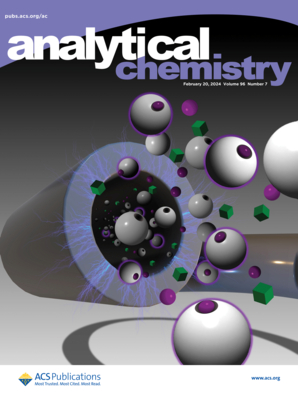Dual-Enhanced Lateral Flow Immunoassay: Synergizing Oriented Antibody Anchoring and Nanozyme Catalytic Amplification for Ultrasensitive Cancer Detection.
IF 6.7
1区 化学
Q1 CHEMISTRY, ANALYTICAL
引用次数: 0
Abstract
Conventional lateral flow immunoassays (LFIAs) suffer from limited sensitivity in detecting low-abundance tumor biomarkers, primarily attributed to inefficient antibody utilization and insufficient signal intensity of nano-immunoprobes. Here, we propose a dual-enhanced LFIA integrating oriented antibody anchoring and nanozyme catalytic amplification for ultrasensitive visual detection of tumor biomarkers, denoted as DEOAN-LFIA. Bimetallic catalyst gold-platinum nanoparticles (Au@Pt NPs) were functionalized with phenylboronic acid to selectively orient antibodies via fragment crystallizable (Fc) glycans for improving antibody utilization efficiency, thereby enriching target-probe complexes on the test line (T line), realizing the first-step signal amplification. Subsequently, the elevated local concentration of Au@Pt NPs efficiently catalyzed the conversion of chromogenic substrates into colored products, further amplifying the signal from enriched probes on the T line for the second-step signal amplification. Using common tumor markers alpha-fetoprotein (AFP) and carcinoembryonic antigen (CEA) as model targets, DEOAN-LFIA achieved ultrasensitive detection of picogram-level targets (50 pg/mL for AFP and 10 pg/mL for CEA) with rapid analysis within 25 min. Clinical validation with 36 human serum samples demonstrated favorable concordance with the standard clinical assay. This DEOAN-LFIA platform provides a robust ultrasensitive point-of-care tool for the early diagnosis of malignant diseases.双增强横向流动免疫测定:协同定向抗体锚定和纳米酶催化扩增用于超灵敏癌症检测。
传统的侧流免疫测定法(LFIAs)在检测低丰度肿瘤生物标志物时灵敏度有限,主要是由于抗体利用效率低和纳米免疫探针的信号强度不足。在这里,我们提出了一种整合定向抗体锚定和纳米酶催化扩增的双增强LFIA,用于超灵敏的肿瘤生物标志物的视觉检测,称为dean -LFIA。双金属催化剂金-铂纳米粒子(Au@Pt NPs)经苯硼酸功能化,通过片段结晶(Fc)聚糖选择性定向抗体,提高抗体利用效率,从而在测试线上(T线上)富集靶探针配合物,实现第一步信号放大。随后,Au@Pt NPs的局部浓度升高有效催化显色底物转化为有色产物,进一步放大T线上富集探针的信号,进行第二步信号放大。deoa - lfia以常见肿瘤标志物甲胎蛋白(AFP)和癌胚抗原(CEA)为模型靶点,实现了皮图级靶点(AFP为50 pg/mL, CEA为10 pg/mL)的超灵敏检测,并在25分钟内快速分析。36份人血清样品的临床验证与标准临床检测结果一致。这个dean - lfia平台为恶性疾病的早期诊断提供了一个强大的超灵敏的即时护理工具。
本文章由计算机程序翻译,如有差异,请以英文原文为准。
求助全文
约1分钟内获得全文
求助全文
来源期刊

Analytical Chemistry
化学-分析化学
CiteScore
12.10
自引率
12.20%
发文量
1949
审稿时长
1.4 months
期刊介绍:
Analytical Chemistry, a peer-reviewed research journal, focuses on disseminating new and original knowledge across all branches of analytical chemistry. Fundamental articles may explore general principles of chemical measurement science and need not directly address existing or potential analytical methodology. They can be entirely theoretical or report experimental results. Contributions may cover various phases of analytical operations, including sampling, bioanalysis, electrochemistry, mass spectrometry, microscale and nanoscale systems, environmental analysis, separations, spectroscopy, chemical reactions and selectivity, instrumentation, imaging, surface analysis, and data processing. Papers discussing known analytical methods should present a significant, original application of the method, a notable improvement, or results on an important analyte.
 求助内容:
求助内容: 应助结果提醒方式:
应助结果提醒方式:


